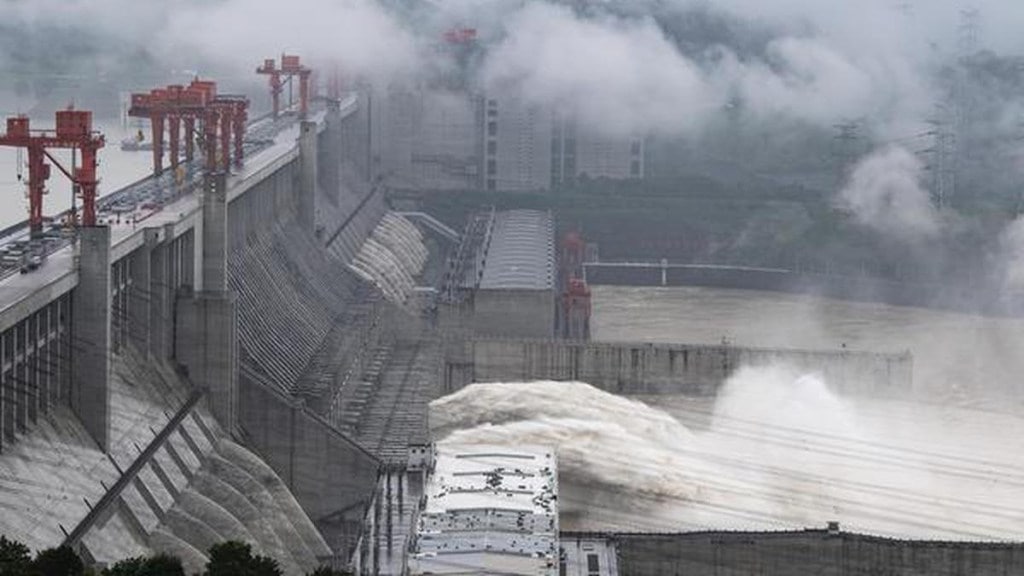China’s decision to build a hydropower dam on Yarlung Tsangpo river and the creation of new counties, parts of which are in Ladakh, threaten to strain ties with India again. Ritwik Sharma looks at the controversies, the politics around dams and why India needs to act with caution
Where is China building the largest dam?
On December 25, 2024, the Chinese government approved the construction of the world’s largest hydropower dam across the lower reaches of the Yarlung Tsangpo river, which enters Arunachal Pradesh as Siang or Dihang and then Assam as the Brahmaputra before flowing into Bangladesh and merging with the Bay of Bengal. The dam will be built at the Great Bend, where the river takes a U-turn, in the Medog county of the Tibetan Autonomous Region. The $137-billion hydropower project is expected to generate around 300 billion kilowatt-hours of electricity annually — potentially three times more energy than the Three Gorges Dam, which is also in China and is currently the world’s largest hydropower plant. The ambitious project was on the anvil for years, and in November 2020 China included a proposal in its 14th Five-Year Plan (2021-25). Rights groups and experts have raised concerns about the effects of the project, fearing displacement of locals and adverse environmental impact on the downstream countries of India and Bangladesh.
What is the controversy over China forming new counties?
Two days later, Chinese state media Xinhua reported that the government of northwest China’s Xinjiang Uyghur Autonomous Region announced the establishment of two new counties. The Central Committee of the Communist Party of China, and the State Council approved the two new counties, which will be administered by Hotan Prefecture in the country’s northwest region. Hotan Prefecture also administers a vast portion of the Aksai Chin region, which India claims but has been under Chinese occupation since the 1950s. India lodged a protest with its neighbour in response to the creation of the two new counties, saying that parts of them fall within the Union Territory of Ladakh. China’s move comes just two months after the two neighbours had announced a patrolling arrangement along the Line of Actual Control leading to the disengagement of militaries in eastern Ladakh.
Impact on bilateral ties
The two developments threaten to undo the improvement in relations between India and China, which were strained since the military clashes in the Galwan valley of Ladakh in June 2020, the first such confrontation since 1975. The two nations had decided to pull back troops in October 2024 and senior officials from both sides met last month to hold formal talks for the first time in five years. India’s external affairs ministry has said that the creation of new counties will not “lend legitimacy to forcible occupation” or affect India’s position on “sovereignty over the area”, and it has also urged China to “ensure that the interests of downstream states of the Brahmaputra are not harmed by activities in upstream areas”. Chinese officials, meanwhile, have said that hydropower projects in Tibet will not have any major impact on the environment or downstream water supplies, and the Yarlung Tsangpo dam is aligned with the country’s carbon neutrality goals by 2060. This week, defence minister Rajnath Singh also said that India was on alert regarding China’s plan to build the mega dam.
The geopolitics of hydro projects
India’s concerns over the mega dam include Chinese control over the flow of water to India, threat to ecological balance and floods, etc., in an earthquake-prone zone of the Himalayas. Geostrategist Brahma Chellaney, in a column for The Hill, pointed out that the dam “is likely to sharpen the Sino-Indian territorial and border disputes, which date back to China’s 1951 annexation of the then-autonomous Tibet”, and China, “the world’s most dammed country”, has increasingly shifted its focus from internal to international rivers. India too has proposed a hydroelectric dam on the Siang with a potential capacity of 11,000 megawatt. Viewed as a counter to China’s upstream projects, it has been facing protests from activists and citizens in Arunachal Pradesh and Assam. Bhutan too has planned and built dams that have worried India and Bangladesh.
What lies ahead for India
The formation of new counties shows that resolving border disputes remain work in progress and India has to act with caution even as it takes steps to normalise bilateral ties. Last year, China had issued 30 new names for places along the LAC in Arunachal Pradesh, which India dismissed as meaningless. The two nations as well as Bhutan and Bangladesh have not signed the UN Convention on Non-Navigable Uses of Watercourses. India and China had signed an MoU on cooperation on transboundary rivers in 2013, but no activity has been undertaken under it. Another MoU on the Brahmaputra, which lapsed in 2023, is to be renewed every five years, a process that is still ongoing. Former Indian ambassador to China Ashok Kantha told Indian Express that India needs to raise its concerns with China “far more forcefully”, rather than engaging in quiet dialogue.

